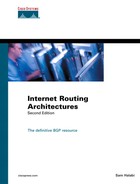Organizing Command Groups in the New Configuration
There is no ambiguity present for command group 1, so they appear as global BGP configuration parameters. These commands appear only once in the configuration.
There is no ambiguity for command group 2, so they follow command group 1 under the global BGP parameters. BGP neighbors, with an exception to a case in VPN, are defined once in the configuration.
A new submode was introduced under router bgp autonomous-system configuration mode to define the per-AF commands.
The following output demonstrates the general configuration guidelines when using the new AF-style CLI:
router bgp autonomous-system address-family afi [sub-afi] redistribute protocol neighbor 1.2.3.4 activate … exit-address-family exit
A neighbor can have different policies applied to a single peer (for example, route-map or prefix-list statements), one per AF.
For configuring IPv4-unicast BGP (vanilla BGP) policy for neighbors, it is possible to configure them entirely under the command group 2. This is very similar to what we have today (old CLI). The address-family ipv4 unicast is implicit, although explicit configuration is recommended.
It is also possible to configure the IPv4-unicast BGP policy using the address-family BGP submode. In the show running-config output, address-family ipv4 unicast is shown, and IPv4-unicast global (global to per-AF) and policy (AF-specific per-neighbor/peer group) commands are listed within the mode.
Under the address-family submode, the commands of the global to per-AF group appear first. These are commands that are global to the AF.
Following the global to per-AF commands are the AF-specific per-neighbor/peer group commands. These commands implement the policy to the neighbors for that AF.
Before any policy is defined for a neighbor under an AF, the neighbor should be "activated" for that AF. The command syntax required to activate a neighbor under a specific AF is as follows:
router bgp autonomous-system address-family afi [sub-afi] neighbor 1.2.3.4 activate … exit-address-family exit
The new configuration structure looks like this:
router bgp 1 no synchronization ! Global to BGP bgp deterministic-med ! Global to BGP bgp bestpath med confed ! Global to BGP neighbor ebgp peer-group ! Peer group defn., global to BGP neighbor 1.1.1.1 remote-as 2 ! Neighbor defn., global to BGP neighbor 2.2.2.2 remote-as 1 ! Neighbor defn., global to BGP neighbor 3.3.3.3 remote-as 3 ! Neighbor defn., global to BGP ! address-family ipv4 unicast ! Address-family IPv4-unicast bgp scan-time 45 ! Global to IPv4-unicast aggregate-address 50.0.0.0 255.255.0.0 ! Global to IPv4-unicast neighbor ebgp activate ! Activate neighbor for IPv4-unic neighbor ebgp route-map ucast-out out ! Peergroup IPv4-unicast policy neighbor 1.1.1.1 activate ! Activate neighbor for IPv4-unic neighbor 1.1.1.1 peer-group ebgp ! Neighbor membership - IPv4-unic neighbor 1.1.1.1 route-map ucast-in in ! Neighbor IPv4-unicast policy neighbor 2.2.2.2 activate ! Activate neighbor for IPv4-unic neighbor 2.2.2.2 route-reflector-client ! RR client - IPv4-unicast neighbor 3.3.3.3 activate ! Activate neighbor for IPv4-unic neighbor 3.3.3.3 peer-group ebgp ! Neighbor membership - IPv4-unic no auto-summary ! Disable IPv4-unicast auto aummarization exit-address-family ! Exit AF sub-mode ! address-family ipv4 multicast ! AF sub-mode network 100.0.0.0 mask 255.255.0.0 ! Global to IPv4-multicast redistribute dvmrp route-map redist-map ! Global to IPv4-multicast neighbor ebgp activate ! Activate neighbor for IPv4-mult neighbor 1.1.1.1 peer-group ebgp ! Neighbor membership - IPv4-mult neighbor 1.1.1.1 route-map mcast-in in ! Neighbor IPv4-multicast polic neighbor 3.3.3.3 peer-group ebgp ! Neighbor membership - IPv4-mult exit-address-family ! Exit AF sub-mode exit
The following sections provide more information on commands.Each section addresses two configuration styles:
The following sections cover configuration guidelines associated with activating a peer, advertising a network, peer groups, route maps, route redistribution, route reflection, and aggregation.
